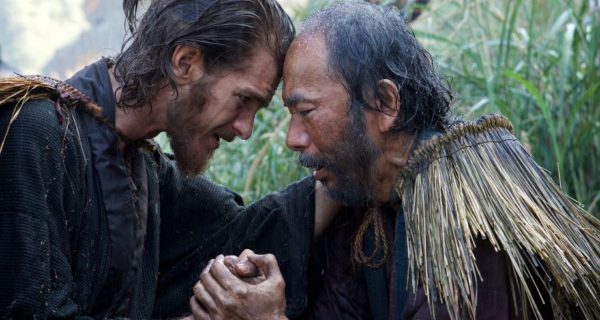~ by Avellina Balestri
The movie Silence, based on the book by the same name which chronicles the persecution against Christians in 17th century Japan, has been pretty controversial in religious circles. In summary, it’s about a Jesuit priest who goes to Japan in search of his missing mentor, who went to the Japanese as a missionary years before and then disappeared. Rumors have it that he apostatized, but the young Fr. Rodrigues refuses to believe it.
However, after a long and harrowing journey through Japan, witnessing the intensity of the persecution against the Christian faithful – who are tortured and brutally killed if they will not step on an image of the face of Christ – Fr. Rodrigues finds his own faith begin to become clouded by doubt. Ultimately, he discovers that the rumors about his mentor are true, and goes on to apostatize himself in order to stop the torture of some Christians in a courtyard.
Now, the controversy bit comes in the form of whether or not the story is somehow lauding Rodrigues for making the “right” decision by stepping on the face of Christ. I actually don’t think that’s the point. He thinks he hears God’s voice giving him the go-ahead, but we’re really not sure. It could be Rodrigues’ own mind allowing for it. But either way, one thing is pretty clear: this is an agonizing decision, and this priest has been broken down in spirit to the point of everything feeling quite morally gray.
It’s not a heroic story, but rather a realistic and very human one. This is a flawed yet genuinely compassionate man caught between a horrible rock and hard place: His love for Christ and his love for Christ’s people. Ultimately, he makes a call for the love of those people and hopes that Christ will understand. He would have gladly gone to his own martyrdom, but watching others tortured over him simply pushed him to the breaking point. Even the strongest among us can break under that kind of pressure.
That having been said, it should be remembered that Rodrigues, even if he held firm and refused to cave, would not have been the guilty party in torturing these Christians: that was squarely in the lap of the extremist Buddhist government, who were slaughtering Christians and claiming their faith was incompatible with the Japanese way of life. If anything, the priest would have been merely upholding the cause for which they were all suffering and dying, and refusing to give the oppressors precisely what they wanted. In essence, if he chose to hold firm, he would not have just been a martyr for Christianity, but also a martyr against tyranny.
But perhaps one of Rodrigues’ character flaws had to do with the fact that his zeal for the faith actually served as something of a mirror to his own pride, and that pride and any sense of spiritual assurance is painfully wrenched from him, leaving him wondering what it’s all been worth. For much of the story, he speaks from a position of righteousness and perhaps allows his mission and “savior syndrome” to blind him to his own ability to fall. In the end, he realizes he is just as weak as the drunken apostate he used to confess and realizes that he is now truly a shepherd at one with the sheep through common brokenness. At last, he is able to feel self-emptied compassion that is truly Christlike.
I think one of the key themes in the story is the idea that even at our darkest point, in the depth of silence and abandonment, Christ crucified is still present to a suffering soul. In our falling beneath the cross, in the depths of sin and death, there too we find Christ’s sacrifice and our salvation. Yes, even a soul that betrayed Christ out of the best of human intentions. Fr. George Calciu remarked, “Christ did not come to explain human suffering, or to eliminate it. Rather, He came to fill human suffering with His presence.”
In some ways, Silence has themes similar to the ever-controversial movie by Martin Scorsese, The Last Temptation of Christ. It’s that uncomfortable, jagged-edged element of temptation and doubt that tends to disturb the faithful with the understandable fear of being swallowed up by our own inner demons and the siren’s song of meaninglessness. The sense I get is that Scorsese himself, in his productions, relates to the dark underbelly of the Christian saga and seeks to explore it.
Frankly, I think he went waaaay overboard with Temptation, and if anyone had even tried to do a film like that about, say, Muhammad, it wouldn’t have even gotten off the ground. But there are some scenes (as in the film Last Days in the Desert) that kind of cut to the complex heart of Christian paradox, such as the nature of the redemption and the hypostatic union of divine and human natures. This messy, sometimes outright disturbing, treatment of historical religious belief is something that is also brought to the fore in Silence.
The final scene of the film, after a lifetime of living an alternate life as an apostate, helping the oppressive Japanese regime identify captured Christian religious items (yeah, Benedict Arnold zone, it seems), we find that Rodrigues, fallen from grace as he may have been, still is found clinging to a tiny image of the crucified Christ as his body is burned in a barrel according to Buddhist rites. There is no music, just the crackling of the fire that melts into the chirp of insects and then the silence.
One cannot help but be left spellbound by the image, of the struggled soul clinging to a suffocated God, and suddenly the raw reality of the Christian mystery becomes born anew in the ashes of death. The Word Incarnate speaks to the silence and begins the harrowing up of hell. And this is “victoria crucis”, the Victory of the Cross.
